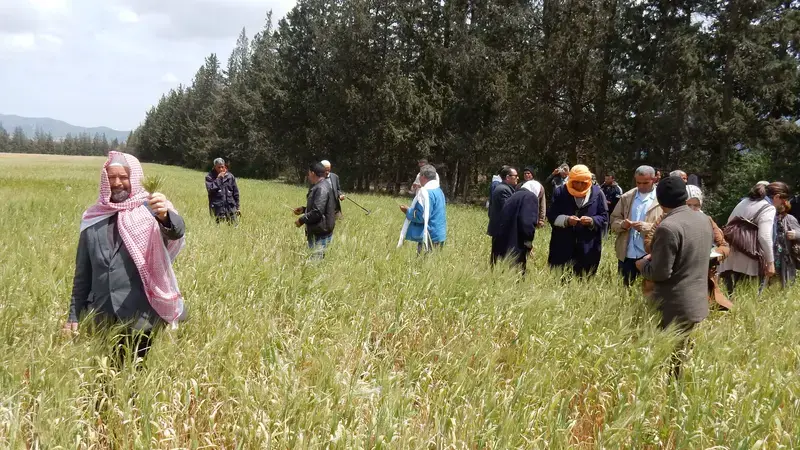Addressing Tunisia’s technology ‘adoption gap’

In Tunisia livestock makes up 4 percent of the country`s GDP and contributes 41 percent of the nation`s total agricultural production. It also plays a critical role in food systems. Despite this importance, productivity is low—most livestock is held by resource-poor farmers using traditional production methods—and this situation is compounded by global challenges related to climate change and market volatility.
Agricultural technologies offer a proven means of raising farmer productivity, incomes, and food security – as well as maintaining livelihoods, ensuring a robust supply of food, and given the strategic importance of the livestock sector, sustaining national development and growth.
However, the adoption rate of new innovations among Tunisia`s smallholder-farmers is poor, particularly among barley-livestock farmers who are prevalent across much of the country. This ‘adoption gap’—typical of many agricultural systems across the dry areas of the developing world—prompted ICARDA to initiate the ‘Mind the Gap’ project, to gain an understanding of the factors that limit or facilitate adoption.
Understanding the multiple factors that control technology adoption
As part of this project, ICARDA researchers undertook a study to investigate the influence of knowledge, perceptions, and attitudes on technology adoption. The study was based on the premise that the decision-making process in agriculture is complex—multiple factors and a multifaceted environment can influence farmers—and assumed that a positive attitude towards an agricultural innovation would increase the likelihood of its adoption.
The analytical framework was applied to the uptake of livestock feed blocks and the improved barley variety Kounouz, and included the following controlling factors:
- Extrinsic and intrinsic factors related to the characteristics of farmers such as socio-demographic and economic factors;
- The characteristics of the external environment, including access to infrastructure and climate change;
- The characteristics of the agricultural innovations - such as their perceived benefits, the knowledge required, access to the technology, and the cost of adoption;
- Communication and extension factors.
Participating farmers received different combinations of improvements—training and subsidized inputs—in different treatment groups. The groups were divided using a randomized control trial (RCT). Group One received technical training; Group Two received technical training in combination with economic and organizational training; Group Three received the same combination as Group Two but also focused on female empowerment—offering trainings exclusively for women; Group Four obtained technical training focused on female empowerment only; and finally, a control group did not receive any support.
Data for the impact analysis were collected through a follow-up survey subsequently conducted in December 2018. The 671 participating female and male farmers answered a questionnaire divided into 17 modules to help identify the variables that may have influenced the decision to adopt new technologies.
These included: household socio-economics; household assets (land ownership, the cost of renting land, and access to communal pastures); crop management strategies (based on the quantity, price, and source of inputs); livestock possession (marketing, technology, and nutrition); perceptions and adoption of new technologies by households; household social networks (knowledge, number of contacts, and distance to neighbours); other sources of income; access to socio-economic infrastructure; system vulnerability; and dietary quality. The results of the questionnaire were presented with descriptive statistics based on frequencies and percentages.
Lessons learned
The results of the study suggested that knowledge, attitudes, and perceptions of innovative technologies played a key role in the adoption decisions of farmers. Innovation characteristics, such as the perceived benefits, the knowledge required to use technology, the cost of the technology, and the availability of inputs and resources, had a major influence on adoption rates.
In the case of Kounouz, the socio-demographic and economic factors of age, education, household assets, and off-farm income, appeared to have a significant positive impact on adoption decisions. However, distance from extension offices was negatively correlated with adoption rates, and the characteristics of the external environment, mainly the occurrence of drought, encouraged farmers to continue using local seeds instead of Kounouz.
The results also suggested that owning a motorbike encouraged households to adopt feed blocks—since they provided a means to transport the technology, enhancing its accessibility. In addition, female-headed households were more likely to adopt the feed blocks than male-headed households.
Recommendations
Considering the importance of the external environment, the study suggests that programs addressing drought and soil erosion should be introduced alongside water harvesting schemes—thereby helping to enhance the resilience of farmers already facing the adverse consequences of climate change.
Ultimately, the study sees the role of extension and training as crucial in the development of knowledge, perceptions, and attitudes about agricultural innovations—and a lack of communication between farmers and extension agents can undermine this relationship significantly. Extension agents, the study argues, should focus less on simply providing new technologies, and instead modify their communication and dissemination activities so they become catalysts of a new extension strategy that raises technology adoption rates.
To find out more about the study read the ICARDA working paper.
